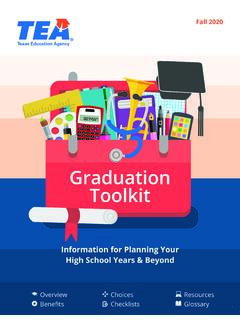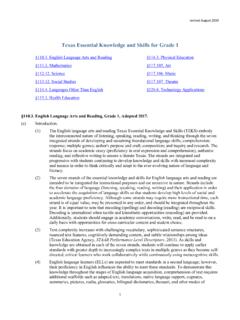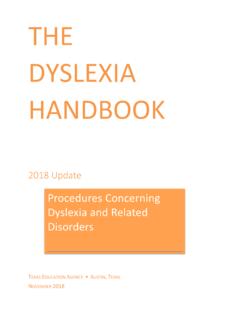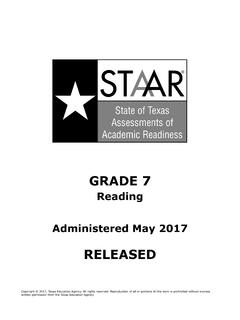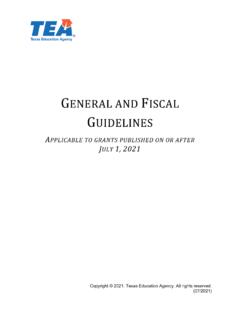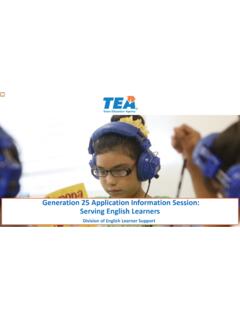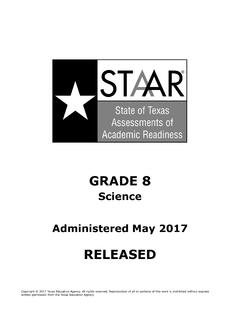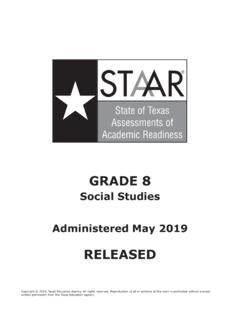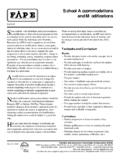Transcription of Texas Education Agency Graduation Toolkit
1 OverviewBenefitsChoicesChecklistsResourc esGlossaryTexas Education AgencyGraduation Toolkitincluding information about the new Foundation High School ProgramInformation for Planning Your High School Years & BeyondGraduation Program - OverviewDistinguished Level of Achievement - BenefitsTexas High School Diploma - StepsEndorsements - ChoicesGraduation Program - ChecklistsInformation - University Information - WorkforceGraduation Program - GlossaryTexas Education AgencyGraduation ToolkitBR14-130-02 Foundation High School ProgramA new, more exible Graduation program that allows students to pursue their interestswill be in place for all students who enter high school, beginning in the 2014-2015 school program contains up to four parts: A 22-credit foundation program which is the core of the new Texas high school diploma Five endorsement* options that allow students to focus on a related series of courses A higher performance category called Distinguished Level of Achievement Performance Acknowledgments that note outstanding achievementThe Foundation requirements (22 credits) include.
2 English (4 credits) English I English II English III An advanced English course Mathematics (3 credits) Algebra I Geometry An advanced math courseScience (3 credits) Biology Integrated Physics & Chemistry or an advanced science course An advanced science course Social Studies (3 credits) World History or World Geography History Government (one-half credit) Economics (one-half credit)Languages Other Than English (2 credits) 2 credits in the same language or 2 credits from Computer Science I, II, IIIP hysical Education (1 credit) Fine Arts (1 credit) Electives (5 credits)Speech: Demonstrated pro ciencyEndorsements Total credits with endorsements 26 EnhancementsAdditionally, a student may earn the Distinguished Level of Achievement and/or a Performance Acknowledgment for outstanding performance. The Distinguished Level of Achievement must beearned to be admitted to a Texas public university under the Top 10 percent automatic admission Level of Achievement Performance Acknowledgments Foundation Program requirements dual credit course 4 credits in math including Algebra II bilingualism and biliteracy 4 credits in science PSAT, ACT s plan , SAT or ACT at least 1 endorsement advanced Placement or International Baccalaureate exam earning a nationally or internationally recognized business or industry certi cation or license *A student entering 9th grade must indicate an endorsement he or she plans to follow.
3 A student may change or add an endorsement at any time. A student may graduate without earning an endorsement if, after his or her sophomore year, the student s parent signs a form permitting the student to omit the endorsement Education Agency Graduation ToolkitGraduation Program OverviewTEXAS Education AGENCYTHE STATE OF Texas Texas Education Higher Education Coordinating Workforce CollegeCredentialBR14-130-02 Choices determine options Most of the very best jobs available now and in the future require Education and training beyond a high school diploma. Whether you intend to pursue a high-demand, industry workforce credential from a community or technical college or a traditional four-year degree from a university, the choices made in high school will determine your future best prepare yourself now for the transition to post-high school Education or quality workforce training, choosing and taking the right classes is essential.
4 The Distinguished Level of Achievement will ensure the best preparation for your it matters BenefitsThe Distinguished Level of Achievement opens a world of educational and employment opportunities for you beyond high school. The Distinguished Level of Achievement will: Allow you to compete for Top 10% automatic admissions eligibility at any Texas public university; Position you among those rst in line for a Texas Grant* to help pay for university tuition and fees; and Ensure you are a more competitive applicant at the most selective colleges and it meansThe Distinguished Level of Achievement requires more math and more science than the Foundation High School Program. The Distinguished Level of Achievement requires: A total of four credits in math, including Algebra II; A total of four credits in science; and Successful completion of an endorsement in your area of Opportunity to earn an endorsement in an area of interest More college and university options More nancial aid options Better preparation for college-level coursework at community/technical colleges and universities Opportunity for immediate enrollment in classes related to your chosen eld of study Strong foundation to successfully complete an industry workforce credential or college degreeTexas Education Agency Graduation ToolkitDistinguished Level of Achievement Benefits*Must be nancially quali edBR14-130-02 Texas Education Agency Graduation ToolkitTexas High School Diploma StepsSTEMB usiness & IndustryPublic ServiceArts & HumanitiesMulti-Disciplinary StudiesSTEMB usiness & IndustryPublic ServiceArts & HumanitiesMulti-Disciplinary Studies22 Credits for the Foundation High School
5 ProgramRequirements of 1 Endorsement(including 4th credit of Math and Science and 2 additional electives) Texas Education Agency Texas Higher Education Coordinating Board Texas Workforce CommissionBe sure to visit your school counselor to learn more about your may earn more than one Level of Achievement26 Credits Algebra II Required Eligible for Top 10% Automatic Admissions to Texas Public UniversitiesENDORSEMENTSBR14-130-02 EndorsementsFor the rst time, students will be able to earn one or more endorsements as part of their Graduation requirements. Endorsements consist of a related series of courses that are grouped together by interest or skill set. They provide students with in-depth knowledge of a subject must select an endorsement* in the ninth grade. Districts and charters are not required to o er all endorsements. If only one endorsement is o ered, it must be multi-disciplinary studies.
6 Students earn an endorsement by completing the curriculum requirements for the endorsement, including 4th credit of math and science and 2 additional elective can choose from 5 endorsement areas*Visit your school counselor to learn more about your options. Students may earn more than one Studies (one of the following) 4 advanced courses from other endorsement areas 4 credits in each foundation subject area, including English IV and chemistry and/or physics 4 credits in advanced Placement, International Baccalaureate, or dual credit selected from English, mathematics, science, social studies, economics, LOTE or ne artsArts and Humanities (one of the following) 2 levels each in two languages other than English (LOTE) Social Studies 4 levels in the same LOTE American Sign Language (ASL) Courses from one or two areas (music, theater, art, dance) in ne arts English electives not included in Business and IndustryPublic Service (one of the following)
7 Human Services Health Science Education and Training Law Public Safety Government and Public Administration Corrections and Security Junior Reserve O cer Training Corps (JROTC)Science, Technology, Engineering and Mathematics (STEM) Career and Technical Education (CTE) courses related to STEM Computer Science Mathematics Science Combination of no more than two of the categories listed aboveBusiness and Industry (one of the following or a combination of areas) Agriculture Food and Natural Resources Architecture and Construction Arts Hospitality and Tourism Technology and Communications Audio/Video Information Technology Business Management and Administration Finance Manufacturing Transportation or Distribution and Logistics Marketing Technology Applications English electives in public speaking, debate, advanced broadcast journalism, advanced journalism including newspaper and yearbookTexas Education Agency Graduation ToolkitEndorsements Choices8th Grade9th/10th Grade11th/12th GradeBR14-130-02 Explore interests and take advantage of Career Day opportunities.
8 Attend college nights hosted by your high school. Talk with school representatives about the types of nancial aid available. Take the Preliminary SAT/National Merit Scholarship Qualifying Test in your sophomore year for practice. In your junior year, take the PSAT for eligibility for the National Merit Scholarship Competition. Students who take the PSAT or ACT s plan tend to score higher on the SAT or ACT than those who do not. Monitor high school credits; be sure to meet all local and state requirements by the end of the senior year. Take dual enrollment or advanced Placement courses if possible to earn college credit while still in high school. Keep list of awards, honors and extracurricular activities for scholarship and college applications. Research colleges or universities you are interested in attending. Check admission and application requirements and timelines.
9 Review choices o ered under the Foundation High School Program and the Endorsements to decide on your future academic path. Select the endorsement that best ts your area of personal interest and the major you plan to study in college. Recognize that most college entrance requirements include rigorous advanced courses including Algebra II, higher-level science courses and languages other than English. Take dual enrollment or advanced Placement courses if possible to earn college credit while you are still in high school. Check with your counselor s o ce to learn about available scholarships. Be sure to apply early and for as many scholarships as possible. Do not limit yourself to local scholarships. Consider taking SAT/ACT preparation classes. Sign up and take the ACT and/or SAT test, preferably in your junior year but no later than the fall of your senior year.
10 Fill out the FAFSA (Free Application for Federal Student Aid) early in the spring of your senior year. Apply to college during the fall of your senior Education Agency Graduation ToolkitGraduation Program ChecklistsIf you plan to pursue technical training or enter the workforce after Graduation , see the Information - Workforce Resources page or visit Texas Reality Check at you Bill 5 2013, the Texas Legislature passed House Bill 5 creating a new Graduation plan for Texas students the Foundation High School Program. This webpage provides an array of information including: A side-by-side comparison of the Foundation High School Program and the previous Graduation plans (PDF) A Foundation High School Program Frequently Asked Questions (PDF) Approved Foundation High School Program Rules Detailed information about the state s Graduation plan (PDF)Compare College College TX is an interactive, mobile-friendly web tool designed to help students and parents learn more about Texas public universities and community/technical ranked in the Top 10 percent of their graduating class from an accredited public or private Texas high school are eligible for automatic admission to any Texas public university if they have completed the Distinguished Level of Achievement?
